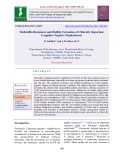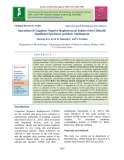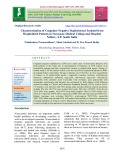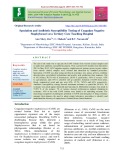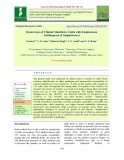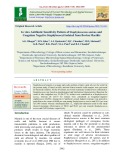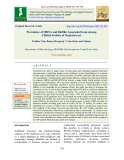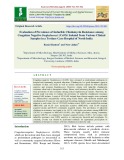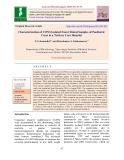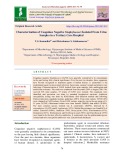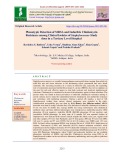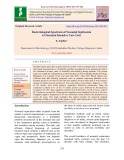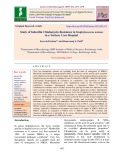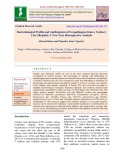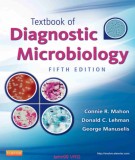
Clinical isolates of staphylococci
-
The present study is therefore conducted to determine the antimicrobial susceptibility patternand surface adherence property of CoNS isolated from various clinical specimens.
 7p
7p  chauchaungayxua12
chauchaungayxua12
 29-07-2021
29-07-2021
 9
9
 0
0
 Download
Download
-
Coagulase Negative Staphylococci (CONS) are the indigenous flora of the human skin and mucous membrane. They are usually contaminants, when isolated from clinical specimens. CONS have become important nosocomial pathogens, accounting for 9% of all nosocomial infections. These infections are difficult to treat because of the risk factors and the multiple drug resistance of these organisms.
 4p
4p  trinhthamhodang1215
trinhthamhodang1215
 23-09-2020
23-09-2020
 10
10
 1
1
 Download
Download
-
Coagulase-negative staphylococci (CNS) are a main cause of nosocomial infection. The main purpose of this study was to determination of frequency of CNS isolates in in hospitalized patients and their susceptibility pattern to antimicrobial agents. During 11 months study, 147CNS clinical isolates were recovered from hospitalized patients in NMC & hospital Nellore south India. The age of patients was 10 t0 70yrs. In vitro susceptibility of isolates to 14 antimicrobial agents – ampicilin, oxacillin, cefexime. azithromycin, oflaxacin, clindamycin, amikacim, tegycyclin, vancomycin, tegycyclin.
 8p
8p  cothumenhmong7
cothumenhmong7
 08-09-2020
08-09-2020
 20
20
 1
1
 Download
Download
-
The aim of the study was to speciate the CoNS isolates from various clinical samples and to study their antibiotic susceptibility pattern. Over a period of 18 months from December 2013 to May 2015, 142 Coagulase negative staphylococcal isolates grown in pure culture from various clinical samples were isolated and identified by standard procedure. Speciation of CoNS was done using novobiocin resistance test, urease activity, ornithine decarboxylase, pyrrolidonyl arylamidase and aerobic acid production from mannose.
 9p
9p  trinhthamhodang7
trinhthamhodang7
 31-08-2020
31-08-2020
 11
11
 1
1
 Download
Download
-
The present study was conducted on clinical cases of mastitis in cattle where isolation, identification of udder pathogens and antimicrobial susceptibility of isolated staphylococci was carried out. A total of 565 quarters milk samples of 142 cattle were investigated and among these 394 quarters were found to be infected. Occurrence of mastitis was found to be highest during third and fourth parity and up to first month of post-partum.
 8p
8p  caygaocaolon6
caygaocaolon6
 30-07-2020
30-07-2020
 14
14
 1
1
 Download
Download
-
Aims of the study are to detect biofilm producing Staphylococcus epidermidis isolated from various clinical specimens. Total 73 Staphylococcus epidermidis isolates were collected from clinical samples like blood, post-operative wound swabs, IV catheter tips, catheterized urine, and exudates received from various clinical departments. The study was carried out over a period of one year.
 7p
7p  quenchua6
quenchua6
 15-06-2020
15-06-2020
 12
12
 1
1
 Download
Download
-
Staphylococcal mastitis is a major and costly problem of dairy cattle all over the world. In the present study, Clinical (n=165) and sub-clinical mastitic milk samples were processed for bacterial isolation. All the 83 isolates recovered on primary isolation were confirmed as Staphylococcus spp. based on morphological and biochemical characteristics. Based on the result of tube coagulase test, 55 (66.27 %) isolates were considered as a Staphylococcus aureus, whereas 28 (33.73 %) isolates were considered as Coagulase-negative staphylococci (CoNS).
 8p
8p  angicungduoc5
angicungduoc5
 12-06-2020
12-06-2020
 17
17
 1
1
 Download
Download
-
Staphylococcus spp is a major cause of nosocomial and community-acquired infections and represents a significant burden on the healthcare system. Establishment of a mature biofilm, play an important role in the persistence of chronic infections and also decreases the susceptibility to antimicrobials and immune defenses, making these infections difficult to eradicate. MRSA and MR-CONS has become a major public health problem in both hospitals and communities. PVL has been reported to be an important marker for the highly pathogenic community acquired S. aureus infections.
 8p
8p  trinhthamhodang4
trinhthamhodang4
 22-03-2020
22-03-2020
 7
7
 0
0
 Download
Download
-
Coagulase-negative Staphylococci (CoNS) have emerged as predominant pathogens in hospital and community acquired infections. Clindamycin is a good therapeutic agent in treatment of skin, soft tissue as well as serious infections caused by both methicillin sensitive and resistant Staphylococci. However, strains with inducible clindamycin resistance often lead to therapeutic failure. Hence, each laboratory should be aware of the local prevalence of this resistance among clinical staphylococcal isolates.
 10p
10p  cothumenhmong4
cothumenhmong4
 25-03-2020
25-03-2020
 10
10
 0
0
 Download
Download
-
Coagulase negative staphylococci (CoNS) were generally considered to be contaminants in the past having little clinical significance. Over the past two decades, these organisms have become recognized as important agents of human disease. S. epidermidis is the predominant agent in nosocomial infection, bacteremia, surgical wound and urinary tract infections. Their pathogenic potential is being increasingly understood and also causing problems to clinicians because of their drug resistance.
 7p
7p  trinhthamhodang3
trinhthamhodang3
 12-02-2020
12-02-2020
 10
10
 0
0
 Download
Download
-
Coagulase negative Staphylococci (CoNS) were generally considered to be contaminants in the past having little clinical significance. Over the past two decades, these organisms have become recognized as important agents of human disease. S. epidermidis is the predominant agent in nosocomial infection, bacteremia, surgical wound and urinary tract infections. Characterization of CoNS isolated from urine samples, their antibiogram and methicillin resistance. The study was conducted from December 2014 to August 2015. We received 518 urine samples, 33 strains of CoNS were isolated.
 6p
6p  trinhthamhodang3
trinhthamhodang3
 12-02-2020
12-02-2020
 20
20
 0
0
 Download
Download
-
Antibiotic discs made by different manufacturers may vary in their working potencies for various reasons and this can affect implementing standard interpretative criteria for reporting susceptibility patterns for certain key antibiotics.
 11p
11p  nguaconbaynhay3
nguaconbaynhay3
 07-02-2020
07-02-2020
 21
21
 2
2
 Download
Download
-
Staphylococcus aureus is a versatile human pathogen causing infections ranging from relatively mild skin and soft tissue infection to life threatening sepsis, pneumonia and toxic shock syndrome. The increasing incidence of a variety of infections and, especially, the expanding role of community-associated methicillin-resistant S. aureus (MRSA)--has led to emphasis on the need for safe and effective agents to treat both systemic and localized staphylococcal infections. Clindamycin is considered to be one of the alternative agents in these infections.
 10p
10p  nguathienthan2
nguathienthan2
 26-12-2019
26-12-2019
 38
38
 0
0
 Download
Download
-
Neonatal septicemia either acquired from the mother (vertical transmission) or nosocomial (horizontal transmission) is a forbidable problem encountered in the neonatal unit and is the commonest primary cause of morbidity and mortality among neonates. The present study was conducted in Department of Microbiology, Dr B R Ambedkar Medical College, Bengaluru, over a period of one year from June 2016 – May 2017. Blood sample were collected from 100 clinically suspected cases of neonatal septicemia admitted in the neonatal intensive care unit.
 4p
4p  quenchua2
quenchua2
 16-12-2019
16-12-2019
 14
14
 0
0
 Download
Download
-
Very few therapeutic options are available from the time of emergence of MRSA. Macrolide lincosamide streptogramin B (MSLB) antibiotics can be used in such scenarios with clindamycin being the preferred agent due to its excellent pharmacokinetic properties. Staphylococcal resistance to clindamycin may be inducible (iMLSB - inducible MacrolideLincosamide Streptogramin B resistance) or constitutive. The treatment of patients harbouring iMLSB Staphylococci with clindamycin leads to the development of constitutive resistance, subsequently leading to therapeutic failure.
 8p
8p  kequaidan2
kequaidan2
 13-12-2019
13-12-2019
 32
32
 0
0
 Download
Download
-
Urinary tract infections (UTIs) are one of the most common bacterial infections encountered in clinical practice. The knowledge of etiology and antibiogram of uropathogens helps in starting empirical treatment till the results of antibiotic susceptibility is awaited. Therefore this two year retrospective study was undertaken to determine the bacteriology and antimicrobial susceptibility pattern of UTIs in a tertiary care hospital. Urine samples from patients suspected of having UTI were processed according to standard microbiological techniques.
 7p
7p  nguaconbaynhay1
nguaconbaynhay1
 04-12-2019
04-12-2019
 36
36
 1
1
 Download
Download
-
(BQ) Part 1 of the document Textbook of diagnostic microbiology presents the following contents: Introduction to clinical microbiology (host parasite interaction, control of microorganisms, specimen collection and processing, immunodiagnosis of infectious diseases,...), laboratory identification of significant isolates (staphylococci, anaerobes of clinical importance, enterobacteriaceae, neisseria species and moraxella catarrhalis,...).
 548p
548p  thangnamvoiva3
thangnamvoiva3
 01-07-2016
01-07-2016
 55
55
 5
5
 Download
Download
-
Rifampin Bacteria rapidly become resistant to rifampin by developing mutations in the B subunit of RNA polymerase that render the enzyme unable to bind the antibiotic. The rapid selection of resistant mutants is the major limitation to the use of this antibiotic against otherwise-susceptible staphylococci and requires that the drug be used in combination with another antistaphylococcal agent. Linezolid Enterococci, streptococci, and staphylococci become resistant to linezolid in vitro by mutation of the 23S rRNA binding site. Clinical isolates of E. faecium and E.
 5p
5p  colgate_colgate
colgate_colgate
 21-12-2010
21-12-2010
 66
66
 2
2
 Download
Download
-
Pathogenesis of Fever Pyrogens The term pyrogen is used to describe any substance that causes fever. Exogenous pyrogens are derived from outside the patient; most are microbial products, microbial toxins, or whole microorganisms. The classic example of an exogenous pyrogen is the lipopolysaccharide (endotoxin) produced by all gramnegative bacteria. Pyrogenic products of gram-positive organisms include the enterotoxins of Staphylococcus aureus and the group A and B streptococcal toxins, also called superantigens.
 5p
5p  ongxaemnumber1
ongxaemnumber1
 29-11-2010
29-11-2010
 68
68
 2
2
 Download
Download
CHỦ ĐỀ BẠN MUỐN TÌM








